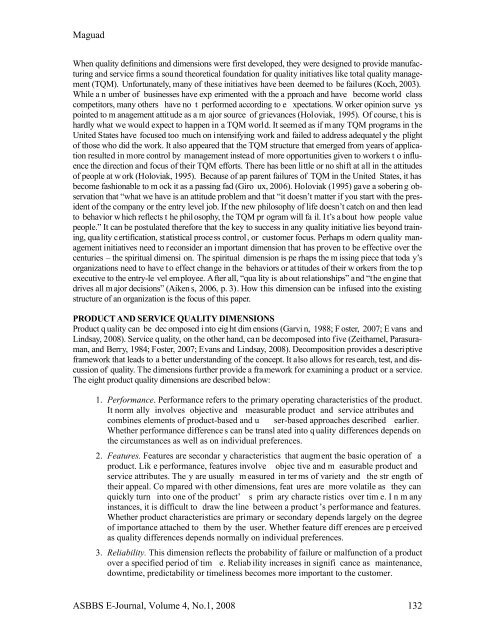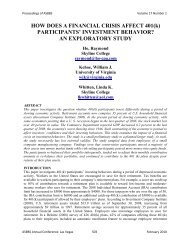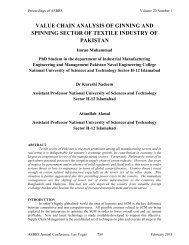stock repurchase announcements: a test of market ... - Asbbs.org
stock repurchase announcements: a test of market ... - Asbbs.org
stock repurchase announcements: a test of market ... - Asbbs.org
You also want an ePaper? Increase the reach of your titles
YUMPU automatically turns print PDFs into web optimized ePapers that Google loves.
Maguad<br />
When quality definitions and dimensions were first developed, they were designed to provide manufacturing<br />
and service firms a sound theoretical foundation for quality initiatives like total quality management<br />
(TQM). Unfortunately, many <strong>of</strong> these initiatives have been deemed to be failures (Koch, 2003).<br />
While a n umber <strong>of</strong> businesses have exp erimented with the a pproach and have become world class<br />
competitors, many others have no t performed according to e xpectations. W orker opinion surve ys<br />
pointed to m anagement attitude as a m ajor source <strong>of</strong> grievances (Holoviak, 1995). Of course, t his is<br />
hardly what we would expect to happen in a TQM world. It seemed as if m any TQM programs in the<br />
United States have focused too much on intensifying work and failed to address adequatel y the plight<br />
<strong>of</strong> those who did the work. It also appeared that the TQM structure that emerged from years <strong>of</strong> application<br />
resulted in more control by management instead <strong>of</strong> more opportunities given to workers t o influence<br />
the direction and focus <strong>of</strong> their TQM efforts. There has been little or no shift at all in the attitudes<br />
<strong>of</strong> people at w ork (Holoviak, 1995). Because <strong>of</strong> ap parent failures <strong>of</strong> TQM in the United States, it has<br />
become fashionable to m ock it as a passing fad (Giro ux, 2006). Holoviak (1995) gave a soberin g observation<br />
that “what we have is an attitude problem and that “it doesn’t matter if you start with the president<br />
<strong>of</strong> the company or the entry level job. If the new philosophy <strong>of</strong> life doesn’t catch on and then lead<br />
to behavior w hich reflects t he phil osophy, t he TQM pr ogram will fa il. I t’s a bout how people value<br />
people.” It can be postulated therefore that the key to success in any quality initiative lies beyond training,<br />
quality certification, statistical process control, or customer focus. Perhaps m odern quality management<br />
initiatives need to reconsider an important dimension that has proven to be effective over the<br />
centuries – the spiritual dimensi on. The spiritual dimension is pe rhaps the m issing piece that toda y’s<br />
<strong>org</strong>anizations need to have to effect change in the behaviors or attitudes <strong>of</strong> their w orkers from the top<br />
executive to the entry-le vel employee. After all, “qua lity is about relationships” and “the engine that<br />
drives all m ajor decisions” (Aiken s, 2006, p. 3). How this dimension can be infused into the existing<br />
structure <strong>of</strong> an <strong>org</strong>anization is the focus <strong>of</strong> this paper.<br />
PRODUCT AND SERVICE QUALITY DIMENSIONS<br />
Product q uality can be dec omposed i nto eig ht dim ensions (Garvi n, 1988; F oster, 2007; E vans and<br />
Lindsay, 2008). Service quality, on the other hand, can be decomposed into five (Zeithamel, Parasuraman,<br />
and Berry, 1984; Foster, 2007; Evans and Lindsay, 2008). Decomposition provides a descriptive<br />
framework that leads to a better understanding <strong>of</strong> the concept. It also allows for research, <strong>test</strong>, and discussion<br />
<strong>of</strong> quality. The dimensions further provide a framework for examining a product or a service.<br />
The eight product quality dimensions are described below:<br />
1. Performance. Performance refers to the primary operating characteristics <strong>of</strong> the product.<br />
It norm ally involves objective and measurable product and service attributes and<br />
combines elements <strong>of</strong> product-based and u ser-based approaches described earlier.<br />
Whether performance difference s can be transl ated into q uality differences depends on<br />
the circumstances as well as on individual preferences.<br />
2. Features. Features are secondar y characteristics that augment the basic operation <strong>of</strong> a<br />
product. Lik e performance, features involve objec tive and m easurable product and<br />
service attributes. The y are usually m easured in ter ms <strong>of</strong> variety and the str ength <strong>of</strong><br />
their appeal. Co mpared wi th other dimensions, feat ures are more volatile as they can<br />
quickly turn into one <strong>of</strong> the product’ s prim ary characte ristics over tim e. I n m any<br />
instances, it is difficult to draw the line between a product ’s performance and features.<br />
Whether product characteristics are primary or secondary depends largely on the degree<br />
<strong>of</strong> importance attached to them by the user. Whether feature diff erences are p erceived<br />
as quality differences depends normally on individual preferences.<br />
3. Reliability. This dimension reflects the probability <strong>of</strong> failure or malfunction <strong>of</strong> a product<br />
over a specified period <strong>of</strong> tim e. Reliab ility increases in signifi cance as maintenance,<br />
downtime, predictability or timeliness becomes more important to the customer.<br />
ASBBS E-Journal, Volume 4, No.1, 2008 132

















